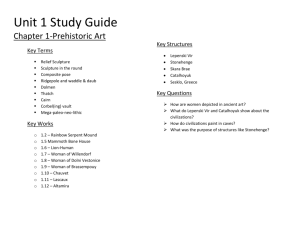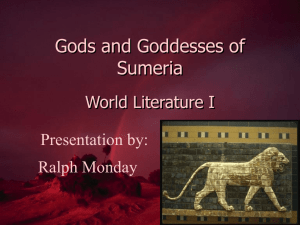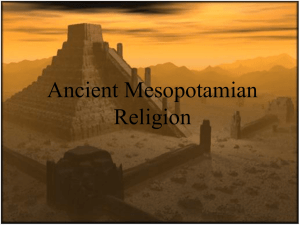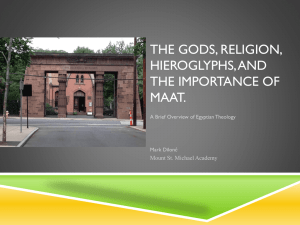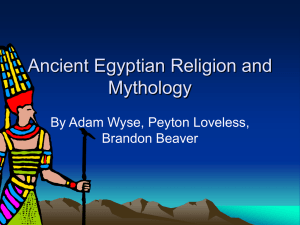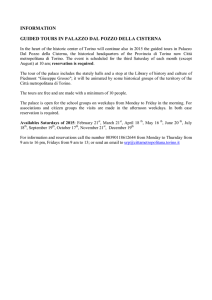Ch2Ancient Near East
advertisement
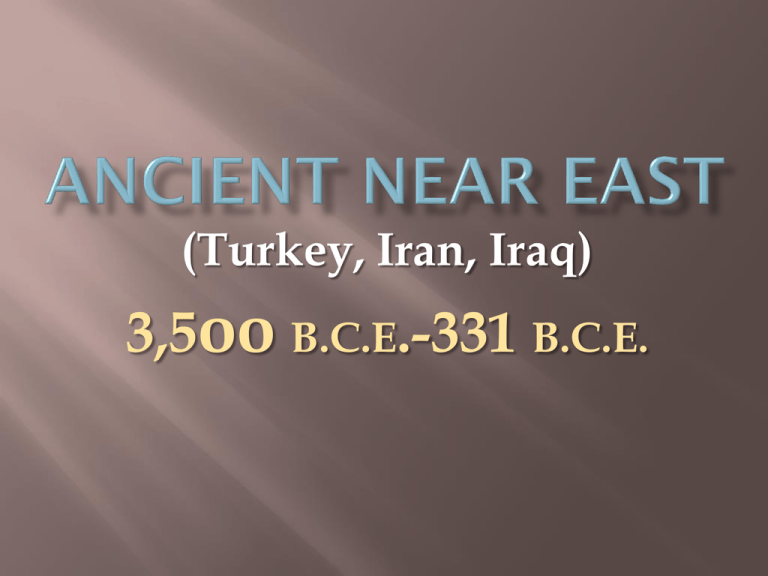
(Turkey, Iran, Iraq) 3,5oo B.C.E.-331 B.C.E. 1st MONOTHEISM 1st organized religion 1st written language CUNEIFORM 1st epic poem, Gilgamesh 1st codes of law: Hammurabi 1st use of Bronze 1st Cities 1st Wheel 1st potter’s wheel c. 8,000 B.C.E. one of the oldest fortified sites Included a tower & walls Dwellings -shelter for the living and housed the dead. Corpses buried under the floors showed a concern for protecting ancestors. c. 7,000 B.C.E. skull was used as an armature on which to rebuild the face with clayto preserve the memory of the deceased? c. 6,000 B.C.E., Turkey Largest Neolithic settlement c. 6,000 B.C.E., Turkey Agriculture & trade well established •Mud brick houses connected by rooftops no streets •Ladders to ground level (for defense?) •Built in benches – seats or beds… It was the largest and oldest planned town Skeletons buried under seats or floors. Dead were decorated with pigment and jewelry and weapons were placed with them (indication of a belief in afterlife?) Are the initials of each (historic) civilization in chronological order. Sumerian c. 3500 B.C.E. Akkadian c. 2100B.C.E. Babylonian Hittite 539 B.C.E. c. 1600-1200 B.C.E. Assyrian Persian c.1792- c.1000-612 B.C.E. c. 559-331 B.C.E. “between rivers” Fertile Tigris and Euphrates fertile area, but not always Dependable, but needed irrigation Biblical Garden of Eden? Crescent Large populations grew Biggest difference between prehistoric world and the Ancient Near East is the new need to urbanize buildings needed for living, governing & worship was great for farming But unlike Egypt which was bordered by deserts and the Mediterranean- Mesopotamia had no such natural defenses to protect it. As a result it was easy to conquer & hard to hold on to. It was an irresistible oasis for outsiders… Egypt was stable and so was its art. It hardly changed in 3,000 years. Mesopotamia’s art changed almost as much as its rulerseach conqueror brought new influences. 3500 B.C.E. cluster of city-states Linked by culture, religion, language: CUNEIFORM st (1 . written Language) CUNEIFORM 1st written Language . Sumer Religion: human race created out of clay for sole purpose of serving the gods. Sumer Death: spirits ferried across river to a gloomy existence below the earth. Afterlife is no fun… This explains the many inscriptions on tablets, in temples, and on sculptures asking gods for a long life. Mother Goddess was the most important deity Sumerians were very devout For DEVOTION to the gods… It housed a smaller temple at the top. Mountain-like Ziggurats dominated the flat landscape. Man made symbolic mountains Sumerians and Babylonians built Ziggurats to put them in touch with the gods, not to elevate their personal egos. (…unlike Egypt and later Near East civilizations…) Only priests were allowed to use the steps to the temple dedicated to Anu, the sky god. 3,000 B.C.E. 3,000 B.C.E. white paint on its outer walls Most Sumerian architecture has disappeared No access to limestone and wood was scarce, so ziggurats were made of mud brick. It was a cheap material and had to be protected from erosion Most mud brick was either painted or faced with tile or stone Through the epic Gilgamesh, we have a written description of the glittering beauty of a Sumerian temple. 3 stairways- each 100 steps many gods Each city had a local god who acted as a spokesman in the assembly of gods (like a U.S. senator) Gods lived in the heavens, but also in their sculptures. Part of a person also lived in their self sculptures. Therefore, putting these sculptures together- you could commune with the gods personally. Abu Temple statuettes (tallest is 30”) are examples Notice the dress and STYLIZED hair and beards Sumerian large eyes because their eyes popped when they saw a god. Being “bug-eyed” meant you were devout. awestruck in the presence of god, can’t take your eyes of him. •beard indicates wisdom •Symmetry •Hands in prayer Sumerian Figures are either hunting, praying, or performing a ritual. upturned face Rippled beard usually painted black (stylized) Female clothing drapes 1 shoulder Important figures are larger and most centrally placed Lyre, c. 2600 B.C.E. Worldly goods found at Burial sites bodies of those ritualistically killed to provide companions for the royal family in the afterlife. Lyre, c. 2600 B.C.E. Stylized human beard of lapis lazuli- a semi-precious blue stone starts ancient tradition of combining animals with human characteristics and emotions. Twisted proportion… Gudea, c. 2100 B.C.E. Stylized calm, peaceful DIORITE, expensive stone- shows off wealth of the owner & importance of the subject Gudea In prayer with an architectural drawing for a temple on his lap. He thought of himself as a patron of temples. c. 2600 B.C.E. historical narrative. frontal /profile. Emphasized eyes, eyebrows, and ears. 2100 B.C.E. Akkadians take over and assimilated much of Sumerian culture. Akkadian & Sumerian gods merged Akkadian rulers elevated themselves to divine status. Sargon I regal determination. Most metal sculpture is lost after defeat it is melted down to be used for other purposes. Big change from Sumerian art is the deification of the king Victory Stele of Naram-Sin c.2230 B.C.E. A stele is a commemorative stone marker Victory Stele of Naram-Sin Naram-Sin grandson of Sargon 6’6” tall very masculine culture Naram -Sin 1st ruler to make himself a god He’s climbing toward heaven (stars above). Victory blessed by gods Wears horned crown of divinity Defeated soldiers beg for mercy Hierarchy of scale Depicts a victory over Lullibi- to be seen forever. It is “carved in stone” He has “made a mark” 1790-540 B.C.E. The capital city beautifully decorated“hanging gardens” and walls of glazed tile. Stele of Hammurabi c. 1780 B.C.E. well ordered state with strict laws handed down from the set of sun god Shamash. Stele of Hammurabi C. 1780 B.C.E. 7’ The relief section at the top is 28” Stele of Hammurabi •1st code of law ever written •300 laws •They stare at one another directly even though their shoulders are frontal “an eye for an eye”- death for a builder who builds a house that collapses and kills the owner. If a surgical patient dies, the hand of the doctor is cut off. The guilt or innocence of an adulteress is determined on whether she sank or floated when thrown in the water. Ishtar Gate C.575 B.C.E. 575 B.C.E. C. named in honor of the Akkadian goddess of love, fertility, and war 575 B.C.E. C. Glazed brick covers mud walls Animals guard entrance to the city Lions sacred to the goddess Ishtar Crenellations give warlike appearance 1600-1200B.C.E. Turkey Turkey kept records in cuneiform on clay tablets stored in an orderly way. cremated their dead (not much tomb art) They had monumental palaces, temples, and cities- and massive fortified walls decorated with relief sculpture. Turkey CITADEL were elevated fortified cities. This shows their power and their need for protection. Lions are guardians of the entrance because of the ancient belief that lions never sleep. Turkey used stone rather than mud brick Large uncut boulders- impressive fortifications. Lion Gate c. 1400 B.C.E. Turkey Gates to the city Guardian lions Huge boulders used in the construction of the city Gives a massive impression 6’6” Hittite war god 1000-612 B.C.E. Rulers intended to conquer the world. But they established libraries, -thousands of tablets recording scientific, historical, literary, and religious, and commercial achievements A masculine society- Figures are stoic Animals showed emotion Man’s domination over the wild beast= symbolic of king’s authority over his people and nature. Assyria=formidable military force . He made boastful claims detailing his cruelty. He intended to conquer the world. Assurnasirpal’s cruelty- “…he dyed the mountains red like wool cloth, with the blood of his slaughtered enemies”, “from the heads of his decapitated enemies he erected a pillar, and he covered the city walls with their skins”. Lions popular- king’s dominance over lions= metaphor for the subjugation of his enemies Architecture was designed to intimidate visitors Extreme detail and musculature Lamassu =bull or lion with wings and a human head a guardian designed to intimidate. 720 B.C.E. He has 5 legs to give the illusion of movement One of the oldest surviving narratives Emotions in animals, not in humans. Lion Hunt C. 640 B.C.E. Palace of Sargon C. 710 B.C.E. City 50 feet high Mud brick Contains ziggurat Huge complex, 200 rooms Assyrian WARLIKE 560-530 B.C.E. Cyrus the Great founded the Persian Achaemenid dynasty. mostly influenced by Assyrians were no Persian temples since religious ceremonies were held outside. There motif of lion attacking bull =characteristic of Persian art Persia was the largest empire so far. first great empire in history. Monumental architecture- audience halls, huge buildings for grand ceremonies that glorified the empire and the rulers. Columns topped with 2 bull shaped capitals holding up a wooden roof Palace at Persepolis Built for spectacular receptions and festivals. Mud brick with stone facing Giant Lamassu gates Palace at Persepolis c. 500 B.C.E. Iran Built by Darius I & Xerxes I destroyed by Alexander the Great. Audience Hall= Palace at Persepolis Apadana had 36 columns covered by a wooden roof. It held thousands of people. It was used for the king’s receptions. Palace at Persepolis Reliefs lining the walls and staircases were originally painted. Palace at Persepolis In contrast to the aggressive military scenes of Assyrian reliefs, Persian reliefs are more solemn. Politically Persia was less cruel and more tolerant. Figures were shown in full profile and not twisted like previous cultures Is a work of art’s place of origin. Pieces are plundered from archeological sites and appear on the market without any record of where they came from. This creates a problem for art historians. They want to know if it was found in a home, a palace, or a temple and what its purpose was… birth of world civilizations. Art serves religion and state Ruler’s image could be permanently emblazoned on a stele to celebrated their achievements for posterity. Writing combined with image =historical and artistic record of human achievement. Common characteristics of Near East art: Union of human and animal elements Hierarchical scale Deification of rulers (ruler is divine) Mud Brick faced with stone or tile or painted. Entrance ways to cities or palaces were importantGuardian figures to protect or ward off evil
